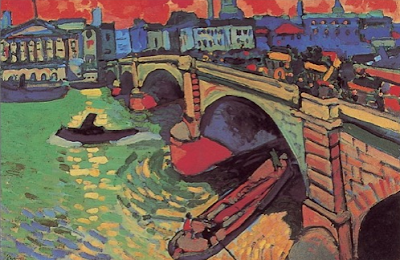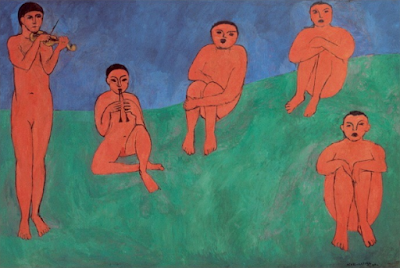-personal vision > external/scientific knowledge
-inward revelation > observation of nature
-term became popular in munich in 1911 in pages of der sturm
PRIMITIVISM/african sources:
-artists collected non-western art
-sculptural effects through facetted planes
-stylized, distorted forms
-led matisse to emphasize surface design
-1906: gauguin's work shown in salon --> lozenge-shaped eyes & stylized faces showed up in fauve art
-signified the exotic or primitive
-absence of accessible iconography or history = easily absorb into modern culture--> decontextualization
-preference for primitive culture was social criticism as well as new art
the theory of the "decorative":
-modern quality: emphasis on painted surfaces-inherent value of a painting was to be derived from a "harmonious" combination of various formal elements
expressionism in france:
fauvism (france)-arbitrary color
-crude & bright
-unsophisticated
-daring, brightly colored
-instinctive, spontaneous expression
-art described as primitive
-wild beasts identified w anti-establishment anarchist tendencies
-corruption in government institutions & military --> political & intellectual anarchism
-color used to create spacial dimension
-fauves adopted mode of spontaneous artistic expression loosely associated w anarchist attitudes but did not have conscious political commitment
-grew out of spirit of joyous, pagan affirmation
-represented return to natural reality after romantic interregnum
-juxtaposition of complementary colors, in wider slashes
henri matisse:
-member of bourgeoisie
-studies w academic painters
-art collector (put in debt bc collecting works of artists he likes)
-le fauve des fauves
-later interest in more controlled mode of painting "an art of balance, purity, & serenity"
-some of his work is associated w more conservative bourgeois tradition
-far from avant-garde thread
-conscious of using color to establish solid form
-influenced by cezanne
 |
| carmelina- matisse 1903 art like cezanne flat, rectangular shapes offsetting the organic, full-bodied figure |
 |
| luxe, calme et volupte (luxury, calm, & pleasure)- matisse 1904-05 spacial perspective utilized w juxtaposing colors |
 |
| woman w a hat- matisse 1905 colors in maximum intensity contours defined by ragged patches of color |
 |
| portrait of madam matisse (the green stripe)- matisse 1905 avoidance of black & grey- impressionist influence |
 |
| le bonheur de vivre (the joy of life) 1906 |
 |
| blue nude: memory of biskra- matisse 1907 anticipates his travel to morocco faces is mask-like voluptuous racial ambiguity |
COMPARED TO:
 |
| reclining nude I- matisse abstracting of the body |
 |
| two women- matisse 1907 new avenue for figuration |
derain:
 |
| london bridge- andre derain 1906 reigned in enthusiasm |
 |
| turning road, l'estaque- andre derain 1906 quasi-abstract patterns |
 |
| street decked w flags, la havre- raoul dufy abstracting from perceived landscape 1906 flag looks 2D- abstraction |
 |
| posters at trouville- dufy 1906 |
- matisse explores masterpieces of islamic art exhibition, munich 1910
 |
| harmony in red- matisse 1908 complementary colors flattening designs |
 |
| the painter's family- matisse 1911 flat patterns |
 |
| the red studio- matisse 1911 single color statement unrelated elements in the room |
 |
| le luxe 11- matisse 1907-8 |
 |
| bathers w a turtle- matisse 1908 |
 |
| dance- matisse 1909-10 bodies= interlocked hands |
 |
| music- matisse 1909-10 reduced palette simplicity of color & line |
 |
| back I, 1909 back II, 1913 back III, 1916–17 back IV, c. 1930 matisse |
- matisse starts collage bc he was immobile
-expression of lines & colors
-line = color, color = line
-body is abstract shape
- deeply subjective german-based vs objective analytical french
________________________________________________
expressionism in germany:
-little taste for pragmatism & logical analysis (inherited from enlightenment)
-more abstract & individualistic
-more obsessive & quirky
-interest in psychology as subject matter
-gothic spirit
-primitive & folk art
-express sense of art through revolutionary link btwn present epoch & creative future
-attract revolutionary & surging elements
-more obsessive & quirky
-interest in psychology as subject matter
the bridge (die brucke):
-dresden, 1906 c. 1911
-anticlassical
-modern art = "too old"
-art that both looked to the past & future
-utopian group-gothic spirit
-primitive & folk art
-express sense of art through revolutionary link btwn present epoch & creative future
-attract revolutionary & surging elements
 |
| girl under a japanese umbrella- kirchner 1909 primtivism- japanese influence --> racist eroticism? figures in background- wallpaper or figures? |
 |
| seated girl (franzi fehrmann)- kirchner 1910 figure in background green on face- internal malaise |
- primitivism spreads to innocence of childhood
- emphasis on mask as a formal device w a lot of symbolism/meaning- used to hide face, reveal something about the self
 |
| two men at a table- erich heckel 1912 |
 |
| standing child- heckel woodcut 1910 (LACMA) franzi fehrmann untainted & uncorrupted |
 |
| somali dancers- max pechstein 1910 woodcut |
- new ethnographic museum that opened in dresden --> new inspirations for primitivism
-art seemed more honest, direct, natural
-turn to woodcut--> primtivism aesthetic, contour, easier to make
-resources available for artists to make prints
-interest in naive/deskilled aesthetic
-native folk art being produced in germany
 |
| woman w dead child- kathe hollwitz 1903 compassion etching bodies unified as if they were one |
 |
| death, woman & child- kathe kollwitz 1910 etching |
- form is as communicative of feeling/emotional content
 |
| moonrise: soldier & maiden- kirchner hand & feet were paralyzed 1905 |
- hitler wanted an exhibit of degenerate art to mock it
blue rider (der blaue reiter), munich:
-1911-1914
-interest in music
-more optimistic










No comments:
Post a Comment